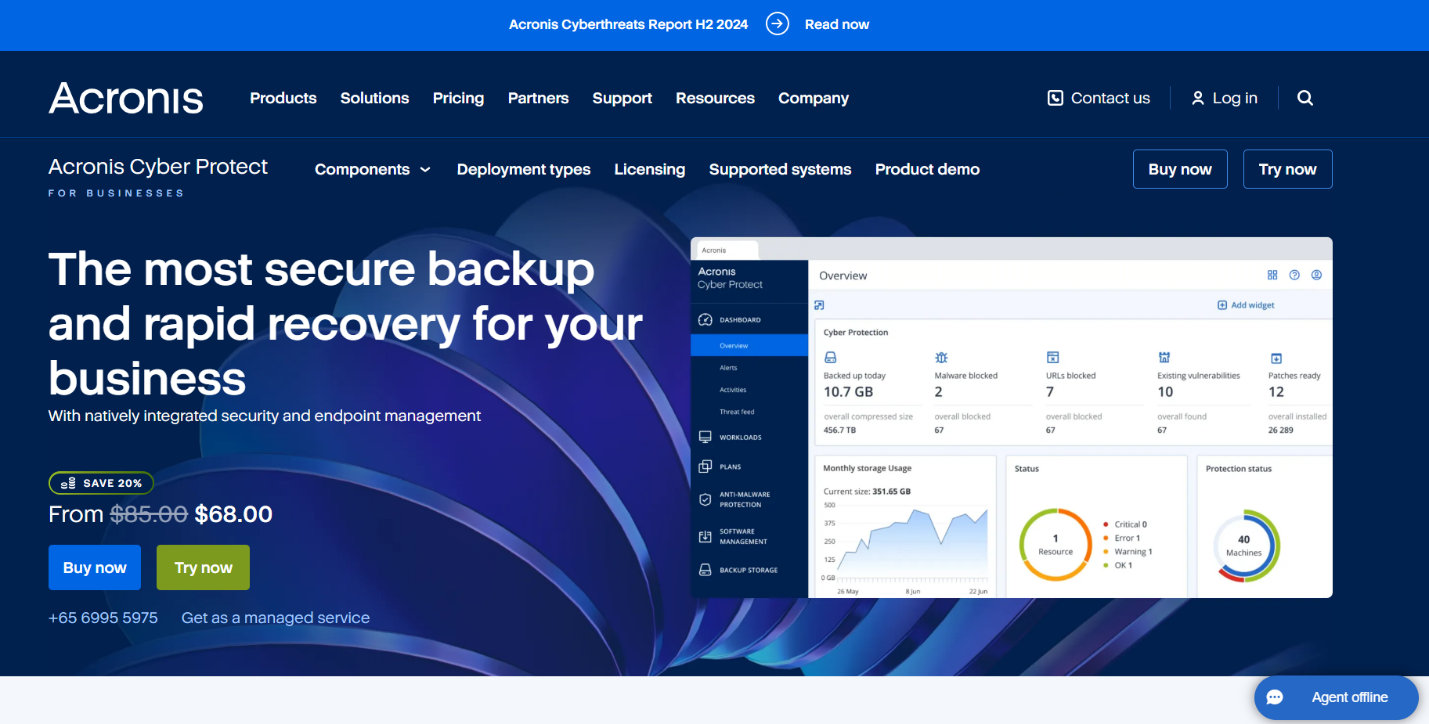

Book a Demo
Thank you! Your submission has been received!
Oops! Something went wrong while submitting the form.

Introduction
In 2025, Disaster Recovery (DR) solutions have become indispensable for ensuring business continuity. Organizations face growing threats from ransomware, natural disasters, cloud outages, and system failures, making it critical to have a robust DR strategy. The evolution of AI-driven automation, hybrid cloud replication, and real-time failover has transformed how businesses mitigate downtime and recover critical data. This guide compares the top 10 disaster recovery solutions that help organizations restore IT operations efficiently and meet global compliance standards.
What is Disaster Recovery and Why is It Important?
Definition & Importance
Disaster Recovery is restoring IT systems and data after a disruption, ensuring business continuity. Key challenges include:
AI-powered and cloud-based DR solutions enhance Recovery Time Objective (RTO) and Recovery Point Objective (RPO) by enabling automated failover and failback capabilities.
Key Features to Look for in Disaster Recovery Solutions
Best Practices for Implementing Disaster Recovery Solutions
How to Choose the Right Disaster Recovery Solution for Your Business?
Best 10 Disaster Recovery Solutions for Business Continuity in 2025
1. Veeam Backup & Replication
Overview: Veeam provides enterprise cloud DR, automated failover, and ransomware protection, ensuring seamless recovery.
Pros:
Cons:
User Ratings:
Screenshot:

2. Zerto by Hewlett Packard Enterprise
Overview: Zerto offers continuous data protection (CDP), instant recovery, and cloud DR with minimal downtime.
Pros:
Cons:
User Ratings:
Screenshot:

3. Commvault Disaster Recovery
Overview: Commvault delivers multi-cloud DR, data replication, and AI-based risk mitigation for advanced security.
Pros:
Cons:
User Ratings:
Screenshot:

4. Druva Phoenix
Overview: Druva Phoenix is a SaaS-based DR solution offering zero-trust security and hybrid backup capabilities.
Pros:
Cons:
User Ratings:
Screenshot:

5. Rubrik Cloud Data Management
Overview: Rubrik provides instant ransomware recovery, automated compliance reporting, and efficient backup solutions.
Pros:
Cons:
User Ratings:
Screenshot:

6. Acronis Cyber Protect
Overview: Acronis integrates AI-powered backup with anti-malware protection and endpoint DR solutions.
Pros:
Cons:
User Ratings:
Screenshot:

7. Datto SIRIS
Overview: Datto SIRIS is a business continuity platform tailored for SMBs with hybrid cloud failover capabilities.
Pros:
Cons:
User Ratings:
Screenshot:

8. Arcserve UDP
Overview: Arcserve UDP offers unified data protection, hybrid cloud DR, and ransomware resilience features.
Pros:
Cons:
User Ratings:
Screenshot:

9. Microsoft Azure Site Recovery
Overview: Azure Site Recovery provides cloud-native disaster recovery and automated failover for Azure workloads.
Pros:
Cons:
User Ratings:
Screenshot:

10. IBM Cloud Disaster Recovery
Overview: IBM Cloud DR leverages AI-powered multi-cloud disaster recovery with fast restoration capabilities.
Pros:
Cons:
User Ratings:
Screenshot:

Comparison Table: Top 10 Disaster Recovery Solutions for Business Continuity

FAQs
What are the best disaster recovery solutions for enterprises in 2025?
Leading solutions include Veeam, Zerto, Commvault, Druva Phoenix, and Rubrik Cloud Data Management.
How do AI-driven DR solutions improve business continuity planning?
AI optimizes failover processes, predicts risks, and reduces downtime through automation.
Can cloud-based DR solutions replace traditional on-prem backup strategies?
Cloud-based DR offers greater scalability, flexibility, and faster recovery options.
What’s the difference between backup & disaster recovery solutions?
Backup solutions store copies of data, while disaster recovery solutions ensure full system recovery and business continuity.
Conclusion
Disaster recovery solutions are no longer optional but essential for maintaining IT resilience in 2025. As cyber threats, cloud outages, and compliance requirements grow, enterprises must adopt AI-driven, cloud-native DR strategies to minimize downtime, prevent data loss, and ensure business continuity.
As Disaster solutions provide visibility into sustainability, compliance, and governance, CloudNuro empowers organizations with deep insights into SaaS and cloud environments, optimizing software spend, licenses, and user management. CloudNuro helps IT and finance teams reduce costs, enhance efficiency, and align with broader Disaster management goals by discovering, eliminating waste, right-sizing licenses, and automating governance.
Want to see how CloudNuro can enhance your data-driven IT strategy while optimizing disaster recovery? Book a free demo today! 🚀
Request a no cost, no obligation free assessment —just 15 minutes to savings!
Get Started

Recognized Leader in SaaS Management Platforms by Info-Tech SoftwareReviews
